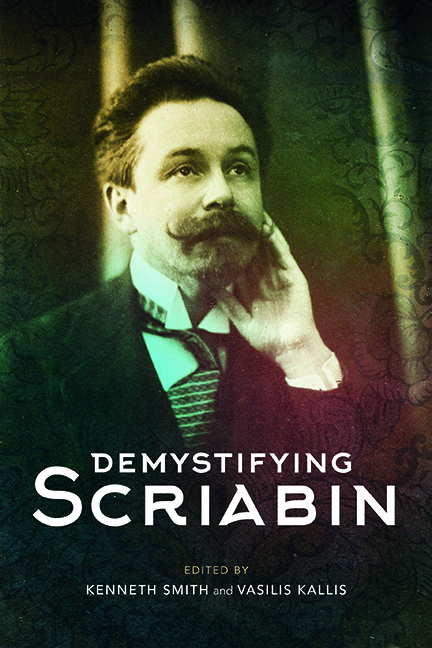1 - About That Chord, and about Scriabin as aMystic
Published online by Cambridge University Press: 07 October 2022
Summary
In the past few years, the A. N. Scriabin MemorialMuseum in Moscow has increased its offerings toinclude concerts, exhibits, lecture series, and‘night in the museum’ events sponsored by Moscow'sDepartment of Culture. Children aged five to eightcan attend a forty-five-minute lecture dedicated tothe composer's childhood, then visit the Museum ofOptical Illusions a block away. Older children areinvited with their parents on a walking tour throughthe Old Arbat neighbourhood, which dates to theeleventh century as a stretch of street lined bywooden houses, stalls, and churches. The workshopsof carpenters and silversmiths ceded to the homes ofnoble families made of stucco with intricatebalconies and fanciful facades. Distinguishednineteenth-century families, including theVolkonskiĭs and Trubetskoĭs, lived on the Old Arbat,as did the poets Pushkin and Tsvetaeva. The 1917Revolution tore it up. Houses were demolished,pedestrian lanes expanded, and pavement was slappedover the tram rails. But Scriabin's residencesurvived. It houses the composer's grand piano,Belgian art nouveau furniture, a small bookcase, aportrait of his mother, the prototype of thecolour-sound keyboard for his 1910 tone poem Prometheus, framed concertannouncements and reviews, images from differentperiods throughout his abbreviated life, andreproductions of paintings by Ferdinand Hodler,Nikolaĭ Shperling, and Leonardo da Vinci on thesubject of death.
On 24–27 April 2015, the museum held four free concertsand an international conference titled ‘Path toScriabin’. Topics included Scriabin's influence onBéla Bartók; his first wife's Jewishness; thereviews of his tamer Romantic compositions in thepages of Russkaia muzykal’naiagazeta; Scriabin's image in the press atthe time of the First World War; his letters toSergeĭ Kusevit͡skiĭ and to Nikolaĭ Struve, managerof the Russische Musikverlag publishing house;Scriabin and Pasternak; and the inspiration theBolshoi Theatre ballet master Aleksandr Gorskiĭ drewfrom Scriabin's music as a prophecy of revolution.As with the family-friendly museum tours, emphasisfell not on the Silver Age itself but what camebefore and after. Russia's great nineteenth-centuryartists had previously come from the noble ranks andthe raznochintsy(middle-class intelligentsia).
- Type
- Chapter
- Information
- Demystifying Scriabin , pp. 11 - 25Publisher: Boydell & BrewerPrint publication year: 2022



